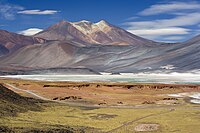
Back Salar de Talar CEB Salar de Aguas Calientes III German Salar de Talar Esperanto Salar de Talar Spanish Talarreko gatz-lautada Basque Salar de Talar French Salar de Talar Swedish Salar de Talar Turkish



Salar de Talar[note 1] is a 46 square kilometres[1] salt flat located in the high puna of northern Chilean Andes, at an altitude of 3,950 m.[1] It is part of a series of salt lakes and salt flats located at the foothills of a chain of volcanoes stretching along the eastern side of the much greater Salar de Atacama.
The closed drainage basin of Salar de Talar encompasses about 476 km2 and is adjacent to other endorheic basins, including Laguna Miscanti, Laguna Tuyajto and Salar de Capur basins.[1] It was once filled by a 31 square kilometres (12 sq mi) large lake connected to Salar Purisunchi.[2]
The salty flat is bordered on the west by Caichinque and on the east by Cerro Medano. This latter is a mountain with striking shades of grey and brown, which contrast nicely with the sparkling white of the salt flat's surface. On top of that, colorful ponds fringe its shores. An important lava flow from the Caichinque volcanic complex formed two lobes which advanced into Salar de Talar.[3] Salt deposits in the salt flat have polygonal shapes.[2]
The climate of the area is arid, with an average annual precipitation of about 150 mm.[1] Salar de Talar is a part of the Central Andean dry puna ecoregion, which in this zone is characterized by tussock grass vegetation.
Cite error: There are <ref group=note> tags on this page, but the references will not show without a {{reflist|group=note}} template (see the help page).
- ^ a b c d (in Spanish) Geoquímica de aguas en cuencas cerradas: I, II y III Regiones - Chile Archived 2011-07-21 at the Wayback Machine Salar de Aguas Calientes 3
- ^ a b Stoertz, George E.; Ericksen, George Edward (1974). "Geology of salars in Northern Chile". Professional Paper. doi:10.3133/pp811. ISSN 2330-7102.
- ^ "Caichinque". Global Volcanism Program. Smithsonian Institution.